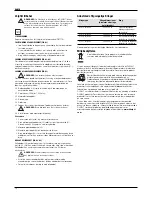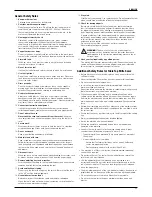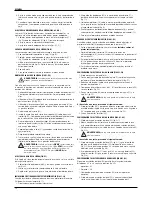
ENGLISH
28
In order to fit a new saw blade it is necessary to adjust the table into highest
position and raise the saw head to its highest position.
1. Retract the lower guard (4) by pushing the release knob (42) in and
sliding the lower guard back. Leave the guard retracted.
2. Using the spanner (39), place the two holes on the outside of the outer
flange (40) (fig. E2).
3. Using the 6 mm hex key, turn the blade bolt (41) clockwise to loosen.
Remove the blade bolt and its outside flange.
4. Remove the saw blade (43).
5. Install the new saw blade onto the shoulder (44) on the inner flange
(fig. E3). Ensure that the teeth at the bottom edge of the saw blade are
pointing towards the fence (away from the operator).
6. Reinstall the outer flange, making sure that the location lugs (46)
(fig. E4) are engaged correctly, one on each side of the spindle.
7. Tighten the blade bolt (41) by turning counterclockwise.
8. Move the lower guard down.
9. After mounting or replacing the saw blade, carry out a complete
movement of the saw head, checking that the movable lower guard
locks in its rest position.
WARNING:
The saw blade
MUST
be replaced as described in
this section.
ONLY
use saw blades as specified under Technical
Data. We suggest DT4375.
NEVER
fit other saw blades.
ADJUSTING THE SAW BLADE (FIG. E2)
If the saw blade is wobbling during start up and run down, then adjust as
follows.
1. Loosen the screw for the arbor collar (40) and rotate the blade (43) a
quarter turn.
2. Retighten the screw and check to see if the blade has any wobble.
3. Repeat these steps until the blade wobble has been eliminated.
MOUNTING AND REMOVING THE FIXED LOWER GUARD (FIG. I1, I2)
When the unit is being used as a saw bench, the fixed lower guard (18)
should always be used (fig. I1).
1. Set the saw head to the vertical position.
2. Loosen locking knob (60) on left side of fence (11) and move fence to
new position as shown (fig. I1).
3. Slide the guard (18) over the rotating table/mitre arm (9) until threads of
head lock down screw align with threaded bushing in head (fig. I2).
4. Depress the head lock up release lever (2) and press down on the head
while tightening the head lock down screw (13).
5. To remove the guard, proceed in reverse order.
STORING THE FIXED LOWER GUARD (FIG. Q1, Q2)
When the unit is being used in mitre saw mode, the fixed lower guard (18)
can be stored on the table (14).
1. Remove fixed lower guard, refer to
Mounting and Removing the
Fixed Lower Guard.
2. Squeeze the fixed lower guard (18) and guide the storage legs (61) into
the slots (62) on the front of the table (14).
3. Push fixed lower guard until the storage legs (61) snap onto the table.
Figure Q2 shows the fixed lower guard in storage position.
4. To remove the guard, squeeze the fixed lower guard and lift guard from
table.
CHECKING AND ADJUSTING THE BLADE TO THE FENCE (FIG. F1–F4)
1. Slacken the mitre latch (8).
2. Place your thumb on the mitre lever (7) and squeeze the mitre latch (8)
to release the mitre arm (9) (fig. F1).
3. Swing the mitre arm until the latch locates it at the 0° mitre position.
4. Check that the two 0° markings (47) on the scale (10) are just visible
(fig. F2).
5. Place a square (48) against the left side of the fence (11) and blade (43)
(fig. F3).
WARNING:
Do not touch the tips of the blade teeth with the
square.
If adjustment is required, proceed as follows:
1. Loosen the screws (49) and move the scale/mitre arm assembly left or
right until the blade is at 90° to the fence as measured with the square
(fig. F4).
2. Retighten the screws (49).
CHECKING AND ADJUSTING THE BLADE TO THE TABLE (FIG. G1–G4)
1. Loosen the bevel clamp handle (12) (fig. G1).
2. Press the saw head to the right to ensure it is fully vertical and tighten
the bevel clamp handle.
3. Place a set square (48) on the table and up against the blade
(43) (fig. G2).
WARNING:
Do not touch the tips of the blade teeth with the
square.
If adjustment is required, proceed as follows:
1. Loosen the bevel clamp handle (12) (fig. G1) and turn the vertical
position adjustment stop screw (50) in or out (fig. G3) until the blade is
at 90° to the table as measured with the square (fig. G2).
2. If the bevel pointer (51) does not indicate zero on the bevel scale (52),
loosen the screws (53) that secure the scale and move the scale as
necessary (fig. G4).
CHECKING AND ADJUSTING THE BEVEL ANGLE (FIG. H1, H2)
The bevel override knob (54) allows the max. bevel angle to be set at 45°
or 48° as required (fig. H1).
– Left = 45°
– Right = 48°
1. Make sure the override knob (54) is located in the left position.
2. Loosen the bevel clamp handle (12) and move the saw head to the left.
This is the 45° bevel position.
3. If adjustment is required, proceed as follows:
4. Turn the stopscrew (55) in or out as necessary until the pointer (51)
indicates 45° (fig. H2).
WARNING:
While performing this adjustment, it is advisable to
take the weight of the saw head by holding it. This will make it
easier to turn the adjustment screw.
ADJUSTING THE RIVING KNIFE (FIG. A2, J1, J2)
The correct position is for the top of the riving knife (15) to be no more than
2 mm below the highest tooth of the blade and the body of the radius knife
to be a maximum of 5 mm from the tips of the saw blade teeth (fig. J1)
1. Adjust the saw bench table to the lower position.
2. Loosen the hex screw (57) which allows both the bracket to rotate and
the riving knife to move up and down (fig. J2).
3. Rotate the bracket and slide the knife either up or down until the
correct position is attained.
4. Retighten the screw (57) firmly.
5. Replace the table.
OPERATION
Instructions for Use
WARNING:
Always observe the safety instructions and
applicable regulations.
WARNING: To reduce the risk of injury, turn unit off and
disconnect machine from power source
before installing
and removing accessories, before adjusting or changing set-
ups or when making repairs. An accidental start-up can cause
injury.
WARNING:
• Ensure the machine is placed to satisfy ergonomic conditions
in terms of table height and stability. The machine site shall
be chosen so that the operator has a good overview and
enough free surrounding space around the machine that allow
handling of the workpiece without any restrictions.
• To reduce effects of vibration make sure the environment
temperature is not too cold, machine and accessory is well
maintained and the workpiece size is suitable for this machine.
•
Ensure the material to be sawn is firmly secured in place.
Summary of Contents for DW711
Page 1: ...www eu DW711 ...
Page 3: ...1 A1 A2 11 12 2 1 5 3 4 7 8 6 10 9 14 17 19 18 58 13 16 15 ...
Page 4: ...2 25 25 20 21 22 23 21 22 20 26 24 27 21 26 29 32 30 31 15 35 34 36 A3 A5 C1 C3 A4 B C2 C4 16 ...
Page 5: ...3 10 47 38 37 41 40 43 39 4 42 44 45 46 40 7 8 9 D E2 E4 F1 E1 E3 E5 F2 41 ...
Page 6: ...4 43 11 48 49 49 12 12 43 48 50 51 53 52 53 54 12 55 51 F3 G1 G3 H1 F4 G2 G4 H2 ...
Page 7: ...5 2 mm 5 mm 15 57 59 58 I1 J1 K M I2 J2 L N 60 11 18 13 2 9 ...
Page 8: ...6 O P A ...
Page 9: ...7 Q1 61 18 14 62 Q2 ...
Page 114: ...112 ...
Page 115: ...113 ...
















































